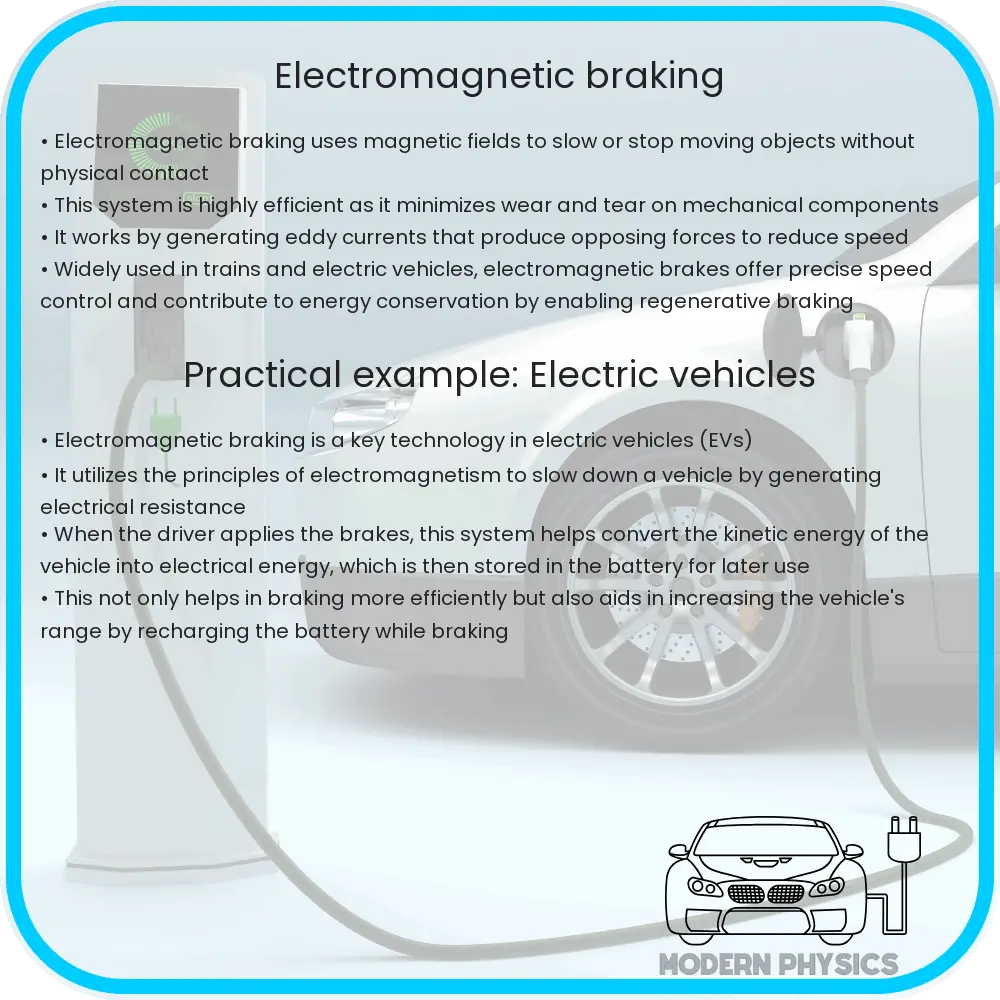Explore the innovative world of electromagnetic braking: its principles, benefits, challenges, and future in transportation and industry.

Understanding Electromagnetic Braking: An Innovative Approach
Electromagnetic braking systems represent a significant leap in braking technology, offering a combination of efficiency, contactlessness, and safety unparalleled by traditional mechanical brakes. This innovative approach leverages the principles of electromagnetism to achieve braking force without direct physical contact, thus reducing wear and tear on components.
Principles of Electromagnetic Braking
The fundamental principle behind electromagnetic braking lies in Lenz’s Law, which states that an induced electromotive force (EMF) always opposes the change that caused it. In the context of electromagnetic brakes, when a conductive material, such as a metal wheel, passes through a magnetic field generated by electromagnets, it induces eddy currents in the wheel. These currents generate their own magnetic field, which opposes the original field, creating a drag force that slows down the wheel.
Components of an Electromagnetic Brake
An electromagnetic braking system typically comprises the following key components:
- Electromagnets: These are the core of the braking system, generating the necessary magnetic field.
- Control Unit: This unit manages the strength of the electromagnetic field, thus controlling the braking force.
- Conductive Rotor: Usually made of metal, the rotor is the part of the vehicle that is slowed down by the induced eddy currents.
Advantages of Electromagnetic Braking
Electromagnetic braking systems offer several distinct advantages:
- Contactless Operation: As there is no physical contact between the brake components, wear and tear are significantly reduced, enhancing the lifespan of the system.
- Efficient Performance: These brakes provide precise control over braking force, allowing for smooth and efficient operation.
- Safety: The absence of friction-based components reduces the risk of brake failure due to overheating or component degradation.
Moreover, electromagnetic brakes are environmentally friendly as they do not generate brake dust, a significant source of pollution from traditional brakes.
Applications of Electromagnetic Braking
Electromagnetic brakes are versatile and find applications in various sectors:
- Transportation: Trains, trams, and electric vehicles benefit from these brakes for their efficient and smooth operation.
- Industrial Machinery: Conveyors, hoists, and other machinery utilize electromagnetic braking for controlled operations.
In conclusion, electromagnetic braking systems stand out as a modern solution to braking needs in various industries. Their contactless nature, efficiency, and safety features make them an attractive alternative to traditional mechanical brakes. The next section will delve deeper into the technical aspects, challenges, and future prospects of electromagnetic braking systems.
Technical Aspects and Challenges of Electromagnetic Braking
While electromagnetic brakes offer significant benefits, they also pose unique challenges. One major technical aspect is the need for precise control over the electromagnets. This requires sophisticated electronic control systems capable of adjusting the magnetic field intensity in real-time to suit different braking requirements. Additionally, the efficiency of electromagnetic brakes depends on the conductivity and magnetic properties of the rotor material, which can vary widely among different applications.
Another challenge is the generation of heat due to eddy currents. Although less significant than in traditional friction brakes, this heat generation still requires management, often through heat sinks or other cooling methods, to prevent performance degradation.
Overcoming Challenges
To address these challenges, advancements in materials science and electronics are crucial. High conductivity materials can improve the efficiency of eddy current generation, while advanced cooling techniques can help manage heat more effectively. Moreover, innovations in control systems, such as the use of smart algorithms and feedback loops, can enhance the precision and responsiveness of electromagnetic brakes.
Future Prospects of Electromagnetic Braking
The future of electromagnetic braking appears promising. As electric and autonomous vehicles become more prevalent, the demand for efficient and reliable braking systems will rise. Electromagnetic brakes, with their ability to provide precise control and minimal maintenance, are well-suited to these new generations of vehicles. Furthermore, the ongoing push for environmentally friendly technologies makes the dust-free nature of electromagnetic brakes particularly appealing.
In industrial applications, the need for precise speed and motion control will continue to drive the adoption of electromagnetic braking systems. Their ability to provide controlled braking without physical wear can significantly enhance the lifespan and reliability of industrial machinery.
Conclusion
In summary, electromagnetic braking systems present a revolutionary approach to braking, marked by efficiency, safety, and environmental friendliness. While they face certain technical challenges, ongoing advancements in materials and electronic control technology are steadily overcoming these obstacles. As industries and transportation systems evolve towards more sustainable and high-tech solutions, electromagnetic brakes stand poised to play a pivotal role. By combining innovative engineering with environmental consciousness, they represent a significant step forward in our journey towards a greener, more efficient future.
